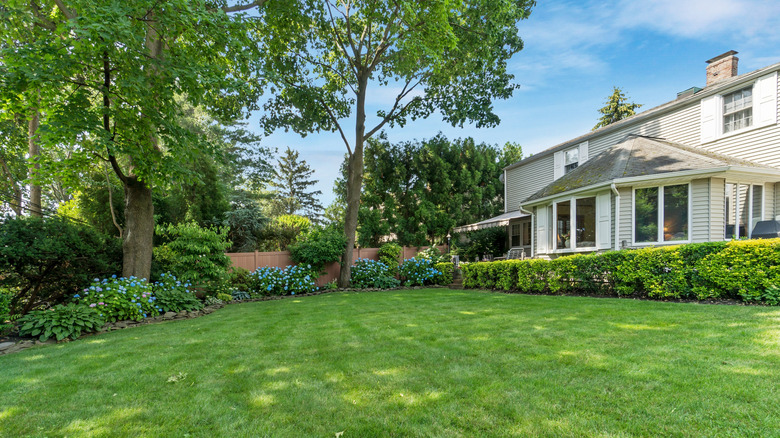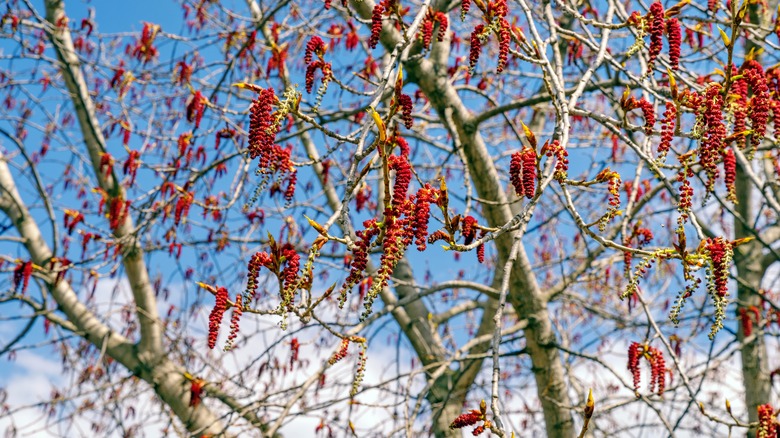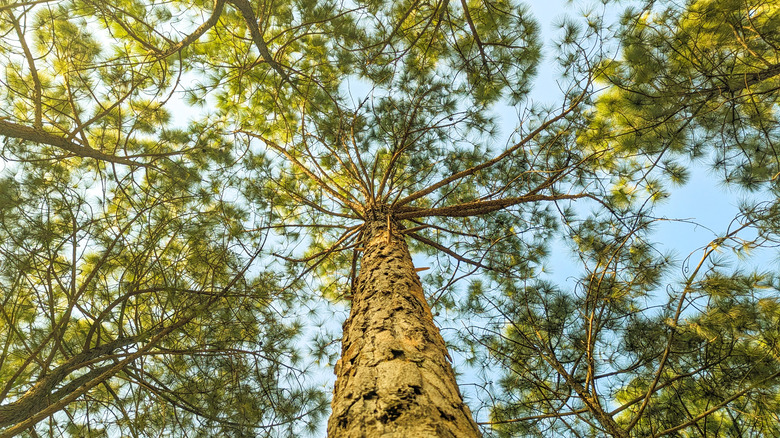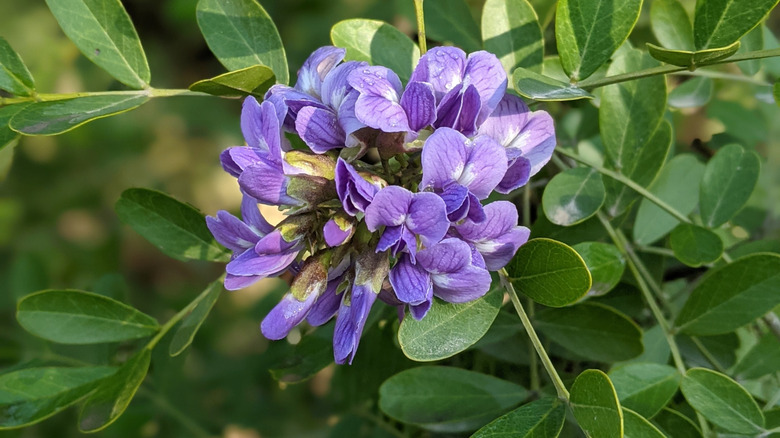22 Native Tree Varieties That Are Beneficial To Your Yard & Local Wildlife
Think about your lawn: A picturesque stretch of carefully manicured green grass that you adore spending time on. However, does it feel like something's missing? Grass-only yards can be visually appealing, sure, but their lack of biodiversity can feel lackluster if you're seeking that breathtaking moment when you step into your yard and you're surrounded by color, birdsong, and wildlife. As a result, you may find yourself on the hunt for the perfect plants to add to your outdoor space that can be beneficial to your yard and the local wildlife — and native trees can be the perfect place to start.
Before diving into the benefits of choosing native plants, you may be wondering: Why trees? Trees can add privacy and shade to your yard, creating a functional space that's more enjoyable to be in. Not only that, but compared to flowers or other smaller plants, trees can be easier to care for in the long-run. Paired with the benefits of choosing native plants, such as increased durability and better support for neighboring animals, adding native trees to your yard can be a great way to help out local wildlife while caring for your yard. With 881 trees native to the contiguous United States, narrowing down the right choice for your yard involves identifying what benefits you want to prioritize (such as creating a biodiverse yard or garden), your local region and climate, and what works best for you.
White alder
What better way to start off this list than with a native tree that offers the best of both worlds in your yard. White alders (Alnus rhombifolia) can pull double-duty in your yard, supporting surrounding plants while also helping out with wildlife. This is because white alders are nitrogen-fixing trees, and they partner up with healthy bacteria to add nitrogen to your soil. They also provide wildlife with shelter, including western tiger swallowtail butterflies, and feed a variety of animals. White alders are native to the western United States and are hardy in zone 6 to zone 10.
Desert willow
Although desert willows (Chilopsis linearis) aren't nitrogen-fixers, they can support your yard in other ways. Native to the southwestern United States, desert willows can be grown as small trees or large shrubs, and they produce flowers that essential pollinators like hummingbirds and butterflies love. This tree also feeds seed-eating birds, if you're looking specifically to attract more birds to your yard for mornings filled with birdsong. Though they aren't a true willow species, desert willows can be useful for controlling erosion if that's a notable concern in your yard. These trees are hardy in zones 7 through 11.
Black willow
Black willows (Salix nigra) are native to much of the eastern and central United States, with USDA growing zones ranging from 4 to 9. In the wild, you're likely to find these plants in damp areas, such as along swamps or other bodies of water. Like desert willows, their intricate root systems are perfect for keeping soil in place, which can be helpful if your yard has heavy erosion. Because they bloom early, black willows are also one of the first food sources for honey bees in the spring. During later months, its twigs and leaves can feed mammals.
Red maple
With striking foliage, red maples (Acer rubrum) can add show-stopping color to your yard. Another eastern and central United States native, these trees sport a board hardiness range, from zone 2 all the way to 9. The main way that red maples are beneficial to your yard and local wildlife is by providing food and shelter to a variety of animals. Their flowers attract pollinators, which can lend a helping hand to other plants in your yard, while their seeds are a popular menu item for non-pollinating birds. They're also a host plant for imperial moths.
Western redbud
Like desert willows, the western redbud (Cercis occidentalis) can be grown as a tree or shrub. With beautiful clusters of stunning pink-purple flowers, it's no surprise that pollinators like hummingbirds, bees, and butterflies are drawn to this tree. Western redbuds are native to the southwestern United States, specifically California, Arizona, and Utah, and are hardy in zones 6 to 9. These trees are another example of nitrogen-fixers. The nodules in their roots contain certain symbiotic bacteria, which help to make nitrogen in the soil usable for plants.
Blackgum
At first glance, blackgum (Nyssa sylvatica) may not seem like much. However, this tree proves good plants don't always come in a showy package. Bees love the nectar from this tree, and songbirds, turkeys, bears, foxes, and opossums are more than happy to enjoy its fruit. It also provides valuable shelter for tree frogs and bats. As a result, while it may not have a direct impact on your yard, it attracts many species that can contribute to beneficial biodiversity in your yard. Native to the central and eastern United States, blackgum is hardy in zones 4 to 9.
Flowering dogwood
If you live in the eastern United States, you'll likely recognize this native flowering tree. The flowering dogwood (Cornus florida) produces white flowers in the spring that give way to fruit come fall. While humans can't eat this fruit, it's a popular pick for songbirds, game birds, and native mammals. And, of course, bees can enjoy its flowers. It's also a host plant for the stunning spring azure butterfly. Dogwood trees can be beneficial for controlling erosion in yards where that may be a problem. This tree is hardy in zones 5 through 9.
Black walnut
Black walnut trees (Juglans nigra) contain a compound in their leaves that can be released into the soil as they decompose and break down. This works like a natural fertilizer, providing a nutrient boost that can help the health of your yard, but plan your garden carefully because some plants may not tolerate these compounds. Your yard aside, black walnut trees also provide food for squirrels, and they're a host plant for some moths and butterflies, including the beautiful lunar moth. They're native to the southern United States and hardy in zones 4 through 9.
American elm
If you have the space to grow this massive tree, the American elm (Ulmus americana) can make a great addition to your yard. Native to the eastern United States, the American elm is a popular tree for providing ample shade while overall being a visually appealing tree. It supports a large variety of insects, including important pollinators like butterflies, and its seeds attract songbirds. Elm trees also help filter water and keep the soil in place for a healthier yard. American elms are hardy from zone 3 to 9, and they're tolerant of many soil conditions.
Sweet bay magnolia
A native to the eastern United States, sweet bay magnolia (Magnolia virginiana) can be grown as a shrub or tree, and its hardiness zones range from 5 to 10. It sports eye-catching and sweet-smelling flowers that can brighten your outdoor space. This magnolia is a host plant for various butterflies that can provide pollination to the rest of your plants, while it feeds wildlife with its seeds. Some magnolias have chemicals in their leaves that can prevent certain plants from growing nearby. When kept away from wanted plants, their erosion-preventing roots and pollinator attraction can be beneficial.
Red mulberry
Your local ecosystem isn't the only thing that can benefit from a red mulberry tree (Morus rubra). This fast-growing fruit tree produces an edible fruit that likely won't show up in your average grocery store. Birds and mammals like opossums also have a taste for red mulberries, while the tree itself is a host plant for the red admiral butterfly. Mulberry trees can also improve soil health through its decomposing nutrient-dense leaves and deep root system. Red mulberries are native to the central and eastern United States and are hardy in zones 4 through 9.
White oak
If you're looking for a tree to help support your native moth populations, look no further than the white oak (Quercus alba). This tree, which is native to the central and eastern regions of the United States, supports at least seven species of moth, all while feeding mammals, songbirds, and gamebirds with its acorns. Hardy in zones 3 through 9, this tree thrives in many climates. White oak also can boost your soil's health: Its roots reduce erosion, and its leaves can add nutrients for other plants.
Eastern redbud
Like the benefits of the western redbud but want a tree that's native to the other half of the United States? Look no further than the eastern redbud (Cercis canadensis). This tree sports a larger climate range than its western counterpart, being hardy in zones 4 through 9, but it remains beneficial for bees, butterflies, and other animals in your yard. While eastern redbuds are in the same family as nitrogen-fixers, they don't do so themselves. They do, however, offer other soil benefits through their roots and leaves.
Wax myrtle
The fast-growing wax myrtle (Myrica californica), however, is a nitrogen-fixing tree to add to your yard if you want a low-maintenance, natural fertilizer. Wax myrtles can be grown as a shrub or tree, and they're native to California, Oregon, and Washington. They grow uniquely shaped fruits that birds love, and butterflies and moths rely on this tree for their offspring. As a result, wax myrtles are another perfect example of a tree that can pull double-duty when it comes to benefiting both your yard and the local fauna. This tree is hardy in zones 7 through 9.
American holly
American holly (Ilex opaca) is an evergreen found native in the central and eastern United States where it's hardy in zones 5 through 9. Along with sporting an iconic appearance during the winter holiday season, this holly plant can add color and life to your yard year-round. As a result, it can be a valuable shelter for local species while also providing food for various insects, mammals, and birds throughout the rest of the year. Although it may not boost soil or benefit your yard on its own, the pollinators it attracts can help your other plants thrive.
Black cherry
Before getting too excited, unfortunately, no, it's not recommended for humans to eat from black cherry trees (Prunus serotina) due to toxicity. There is a silver-lining, however: cedar waxwings can't get enough of the berries, as well as some other songbirds, gamebirds, and mammals. As a result, while you can't enjoy the fruits of your labor, your local wildlife can. If you're struggling to keep your soil in place, black cherry trees can also reduce erosion. Native throughout much of the country, these trees are hardy in zones 2 through 8.
Red alder
Like white alders, red alders (Alnus rubra) are a key example of nitrogen-fixing trees, with that coveted ability to boost nitrogen levels in the soil and help surrounding plants thrive. Red alders also call the western United States home, including Alaska, although their USDA zones are much more limited than white alders, with hardiness set only for zones 5 and 6. When it comes to helping wildlife in your area, red alders may not have as prominent of an impact as other trees on this list. However, they do act as a food source for deer and finches.
Ponderosa pine
With its eye-catching size, you may not be able to fit the mighty ponderosa pine (Pinus ponderosa) in a small yard. However, if you have space to spare, this tree — which is native to the western United States with a hardiness ranging from zone 3 to 7 — offers plenty of benefits for your yard and any nearby animals. Ponderosa pines can be used as a windbreak for more fragile species, and they also help control erosion. A large variety of birds and mammals rely on this tree for food, while other animals use the bark and needles for nesting.
Longleaf pine
Pine trees are a staple in the southeastern United States, especially the towering longleaf pine (Pinus palustris). This tree provides shelter for the red-cockaded woodpecker, an endangered species that's endemic to this area. As a result, to continue seeing these beautiful birds, a healthy longleaf pine population is essential. Moths, foxes, squirrels, gamebirds, and songbirds also benefit from longleaf pines, either for shelter or food. As for your yard, pine straw is one of the best organic mulch options available, and these trees provide plenty. Longleaf pines are hardy in zones 7 through 9.
Anacacho orchid
While not a true orchid, Anacacho orchids (Bauhinia lunarioides) are small trees native to Texas that bloom with beautiful, show-stopping flowers that pollinators love. Finding this plant in the wild can be difficult, because its native range is so slim, but you can find it in some nurseries if you wish to grow it yourself. Along with giving pollinators in your area the fuel they need, Anachacho orchids don't need fertilizers, as they're another example of a nitrogen-fixing tree. These trees are only hardy in zones 9 through 11.
Texas mountain laurel
The soil friendly nutrients don't end with Anachacho orchids. Texas mountain laurel (Sophora secundiflora) offers many of the same benefits, including a stunning array of flowers. They can add nitrogen to the soil that not only benefits the plant itself but those nearby, helping your garden to thrive without high levels of maintenance. Texas mountain laurels are native to the American southwest (think Texas and New Mexico), in USDA zones ranging from 7 to 10.
Pawpaw
Pawpaw trees (Asimina triloba) are a fan-favorite in the insect world. These trees are native throughout the United States, in zones 5 through 9, and they're an essential source of food and shelter for many species. Beetles and flies do most of the work when it comes to pollinating these plants, although its flowers also attract butterflies and other pollinators. Zebra butterflies rely on pawpaw trees as a food source for their offspring, and many mammals, songbirds, and game birds use the fruit for fuel. For erosion-prone yards, pawpaws can be a native, natural solution.






















